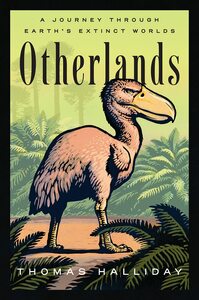Take a photo of a barcode or cover
informative
reflective
slow-paced
informative
fast-paced
Lots of information presented practically and could possibly be used as a good reference to look back on.
hopeful
informative
medium-paced
informative
inspiring
reflective
medium-paced
Traveling backward in time, this book creates glimpses into worlds that existed thousands or millions of years ago. It shows us moments when dramatic change was underway—all these transition helping to create the Earth we live in today.
The order in which the story is told makes it more poignant. Instead of a triumphant march from a barren planet to the rise of humans, it creates more of a sense of how magnificent each of these worlds was in their own right. Humans were not the end game.
And yet, as the epilogue points out, we've reshaped the Earth to meet our needs. Humans are so good at exploiting resources, we've left little behind for other species. That's not something to be ashamed of—that's evolution. But if we don't become better skilled at taking care of our fragile ecosystem, we could soon reshape the Earth in ways that don't serve us. That's the ultimate message of this book. It's a warning but also an expression of hope.
Thanks, NetGalley, for the ARC I received. This is my honest and voluntary review.
The order in which the story is told makes it more poignant. Instead of a triumphant march from a barren planet to the rise of humans, it creates more of a sense of how magnificent each of these worlds was in their own right. Humans were not the end game.
And yet, as the epilogue points out, we've reshaped the Earth to meet our needs. Humans are so good at exploiting resources, we've left little behind for other species. That's not something to be ashamed of—that's evolution. But if we don't become better skilled at taking care of our fragile ecosystem, we could soon reshape the Earth in ways that don't serve us. That's the ultimate message of this book. It's a warning but also an expression of hope.
Thanks, NetGalley, for the ARC I received. This is my honest and voluntary review.
informative
reflective
slow-paced
My reading experience of "Otherlands: A Journey Through Earth's Extinct Worlds" was a roller coaster ride, which was unexpected for a staid nonfiction science book. I started out really excited for it, and I enjoyed the first few chapters. But then the repetitive format and density of the descriptions started to really drag for me, and it got to the point where I was hating it. Not just hating it, but my brain was ACTIVELY REJECTING it. I could read the same sentence 3 times and not derive any meaning from it. My very soul was weary from trying to plow through it. And then, when I had finally struggled my way to the end, I suddenly found the last chapter quite interesting again, and the epilogue was really sharp and thought-provoking. I came away with vaguely positive feelings about the book (also heavy concerns about our environment). So...yeah. A roller coaster.
"Otherlands" explores Earth's natural history and the science of paleontology, with chapters devoted to each epoch and period. Halliday's special twist to this format is that he goes backwards through time - starting with the Pleistocene 20,000 years ago and going all the way back to the Ediacaran period, 550 million years ago. This is a cool idea, but it didn't work well for my brain. In most chapters, he refers both to things that happened in the past (i.e. in chapters that you haven't read yet) and in the future, and I sometimes struggled to think in that backwards direction and to make sense of the jumpy timeline.
Halliday's other main conceit is that he presents each epoch by immersing the reader in one particular landscape, usually a site that is rich in fossils, and describing it like you are there, painting word pictures about the sights, sounds, and smells of that world. Again, I started out enjoying this, but it got old pretty quickly. Just SO MANY WORDS. And I was hoping for more explanations, based in science, about how he determined that a creature was this particular color or that a plant functioned in a certain way. But he rarely gives those facts. You just have to take his word for it (or maybe dig through his references. No thanks).
I will say that the scope of natural history presented in this book is mind-boggling. Each chapter begins with a map of the world, and it is crazy to see how the continents and oceans have changed over the last 350 million years. Truly, just mind-bending to see a map with "North China" floating as an island across the "Rheic Ocean" from "Laurentia" (in the Silurian period, 435 million years ago).
While the maps were helpful, something that really disappointed me is that there is only one drawing per chapter. He describes numerous bizarre and fascinating creatures and plants in each chapter, but you only get a rendering of one of them. And the choice sometimes seemed odd. For example, in Chapter 11 (Carboniferous period, 309 million years ago), he talks about the Tully Monster, which is "unlike anything else that is known in over half a billion years of evolution" and which "utterly confounds understanding," but the one image for that chapter is of trees. 😑🤷♀️ (Go ahead and Google "Tully Monster"...it's bizzaro). Anyways, it seemed like a major missed opportunity not to provide more illustrations throughout.
I will quickly forget all the details shared in this book (except for maybe that Tully monster), but what I will take away from it is the knowledge of how ephemeral humanity is in the history of the planet, how often the climate has changed over these millions of years, how many mass extinction events there have been, and how likely it is that humans are ushering in another one. The epilogue is a matter-of-fact explanation about what humans are doing to the environment and what we can glean about the future from similar episodes in Earth's past...polar ice melting, habitats changing, animals fading away. It is sobering, yet Halliday does not make it feel completely bleak. Honestly, the scope of this book had me feeling almost hopeful, in a dark and fatalistic way. Humans may fundamentally change our current climate; we may kill many of the wild animals that share this epoch with us; we may even destroy ourselves. But the Earth will persist.🌍
"Otherlands" explores Earth's natural history and the science of paleontology, with chapters devoted to each epoch and period. Halliday's special twist to this format is that he goes backwards through time - starting with the Pleistocene 20,000 years ago and going all the way back to the Ediacaran period, 550 million years ago. This is a cool idea, but it didn't work well for my brain. In most chapters, he refers both to things that happened in the past (i.e. in chapters that you haven't read yet) and in the future, and I sometimes struggled to think in that backwards direction and to make sense of the jumpy timeline.
Halliday's other main conceit is that he presents each epoch by immersing the reader in one particular landscape, usually a site that is rich in fossils, and describing it like you are there, painting word pictures about the sights, sounds, and smells of that world. Again, I started out enjoying this, but it got old pretty quickly. Just SO MANY WORDS. And I was hoping for more explanations, based in science, about how he determined that a creature was this particular color or that a plant functioned in a certain way. But he rarely gives those facts. You just have to take his word for it (or maybe dig through his references. No thanks).
I will say that the scope of natural history presented in this book is mind-boggling. Each chapter begins with a map of the world, and it is crazy to see how the continents and oceans have changed over the last 350 million years. Truly, just mind-bending to see a map with "North China" floating as an island across the "Rheic Ocean" from "Laurentia" (in the Silurian period, 435 million years ago).
While the maps were helpful, something that really disappointed me is that there is only one drawing per chapter. He describes numerous bizarre and fascinating creatures and plants in each chapter, but you only get a rendering of one of them. And the choice sometimes seemed odd. For example, in Chapter 11 (Carboniferous period, 309 million years ago), he talks about the Tully Monster, which is "unlike anything else that is known in over half a billion years of evolution" and which "utterly confounds understanding," but the one image for that chapter is of trees. 😑🤷♀️ (Go ahead and Google "Tully Monster"...it's bizzaro). Anyways, it seemed like a major missed opportunity not to provide more illustrations throughout.
I will quickly forget all the details shared in this book (except for maybe that Tully monster), but what I will take away from it is the knowledge of how ephemeral humanity is in the history of the planet, how often the climate has changed over these millions of years, how many mass extinction events there have been, and how likely it is that humans are ushering in another one. The epilogue is a matter-of-fact explanation about what humans are doing to the environment and what we can glean about the future from similar episodes in Earth's past...polar ice melting, habitats changing, animals fading away. It is sobering, yet Halliday does not make it feel completely bleak. Honestly, the scope of this book had me feeling almost hopeful, in a dark and fatalistic way. Humans may fundamentally change our current climate; we may kill many of the wild animals that share this epoch with us; we may even destroy ourselves. But the Earth will persist.🌍
relaxing
fast-paced
This is a wonderful idea for a book, going back through time and describing each era a bit like a travel guide. I did find it heavy going and whilst I'm glad it wasn't dumbed down I did struggle with unfamiliar terms.
Thank you to Netgalley, the publisher and the author for a free copy in exchange for an honest review.
Thank you to Netgalley, the publisher and the author for a free copy in exchange for an honest review.
adventurous
hopeful
informative
inspiring
reflective
slow-paced





